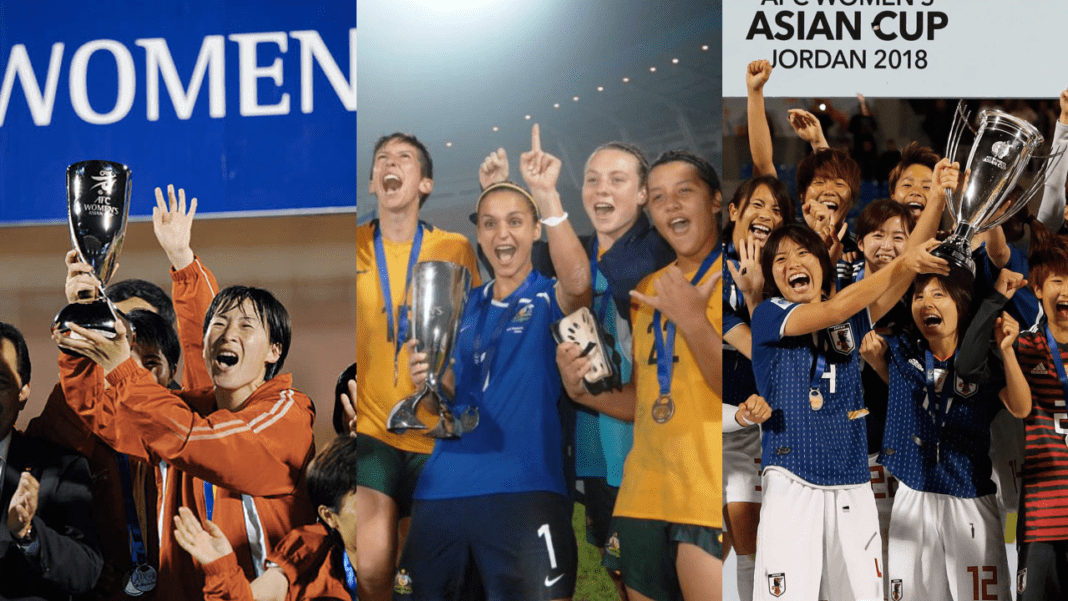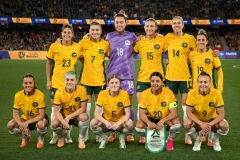

With the Matildas kicking off their 2022 Asian Cup campaign in Mumbai this Friday night, Beyond 90 take a look through the groups and onto the Big Dance to bring you the potential highlights of a brilliant fortnight of football.
From the Azadi to the Asian Cup – Iran takes its bow
Traditionally one of the strongest nations in Asian football, it comes as somewhat of a surprise that Iran finally will make its debut at the 2022 Women’s Asian Cup, becoming the 22nd nation to appear in the tournament’s history.
Well-known to Australian audiences, the country’s men’s team has been a constant power in Asian football, winning three consecutive Asian Cups between 1968 and 1976 and qualifying for four of six World Cups between 1998 and 2018, while Iranian clubs claimed Asian Champions League titles in 1970, 1991 and 1993.
That success on the continental and global stage has eluded the women’s team however, having only played its first official match at the 2005 West Asian Championships – a tournament at which the side finished runners-up – but failing to qualify for any further AFC- or FIFA-sanctioned tournaments.
Despite this lack of 11-a-side success, Iran’s women’s futsal team has had remarkable success, winning both of the two Asian Futsal Championships, and finishing fifth in the World Futsal Tournament in 2015, narrowly missing out on a semi-final appearance to European powerhouse Russia.
Famously barred from the 2012 Olympics over the team’s decision to wear hijabs only for FIFA to overturn their own ruling months later, manager Maryam Iranvoost will be looking to build on her side’s penalty shootout victory against Jordan in Tashkent and push for further success in what is already an historic tournament for Team Melli Baanovaan.
One to watch: Hajar Dabbaghi (20yo – striker)
The Sepahan forward has been scoring for fun recently, notching five goals in Iran’s 2020 Olympic qualifying campaign, and will be looking to add to her tally in India.
The Anagram Derby – Matildas vs Malditas
It would be impossible to preview this tournament without discussing what will be one of the most-anticipated matches in recent Matildas history: the side’s group stage fixture against the Philippines.
On first inspection, there is little history between the two nations in terms of women’s football: eight of the Malditas’ previous nine appearances at the Asian Cup occurred while Australia was part of the Oceania region, while the ninth saw the two teams drawn in separate groups four years ago.
In fact, the single encounter between the two teams is so long ago that of the 18 players in that Australian squad, only half are playing currently, while just five (Polkinghorne, Yallop, Williams, Kellond-Knight and Mastrantonio) have been capped since the last Asian Cup.
When combined, those factors seem to suggest a total lack of familiarity between the two teams; that is, without considering the recent announcement of former Matildas coach Alen Stajčić as the Philippines’ manager for the upcoming tournament.
With his knowledge of both A-League Women and Matildas players, Stajčić adds a crucial element to the Malditas preparation, priming his players for both the technical and tactical task of defeating Asia’s highest-ranked team.
>Having heavily recruited from the United States, Stajčić’s charges will be looking to improve on their previous nine Asian Cup appearances and progress from the group stage, with the side’s final group stage match against Indonesia looming as a potential winner-takes-all playoff for the final place in the quarter finals.
One to watch: Quinley Quezada (24yo – midfielder)
A teammate of A-League Women favourite Alex Chidiac at Japanese club JEF Chiba, Quezada can play as either a winger or striker, and with a record of a goal every other game will be a key outlet for the Philippines as they shoot for the knockouts.
A Real Group of Death – How Group C could shape 2023
With the Football Gods shining down upon them, the four countries in Group C can count themselves equal parts fortunate and unlucky as they head into this year’s tournament.
For Japan, this tournament offers a genuine chance to cement themselves as the Queens of Asia with a third-successive title; for South Korea and Thailand, the chance at another World Cup in 2023 and to upset one of the favourites in Nadeshiko; for Myanmar, the chance to test themselves in only their fifth Asian Cup appearance, and the first outside East Asia.
Those opportunities however are a double-edged sword, with each team snapping at the heels of the others, and there is the real possibility of either of the three teams expected to progress to the 2023 Finals missing out on their place. While one win may be enough to progress as a best third-placed team, expect every match to be a fiery affair with so much on the line.
One to watch: Korea Republic vs Japan – 27 January
If there’s one match of the group stage you HAVE to mark in the diary, it’s this one: the twice-reigning Asian champions vs their fiercest local rivals. With decades of history, a list of stars from across the FA WSL, Division 1 Féminine, the Frauen-Bundesliga and beyond, and a 7pm AEDT kick-off time to boot, fans should be all over this match like a cheap suit.
Three Is The Magic Number – The New Tournament Schedule
After the success of the 2018 tournament, and with the growth of women’s football across Asia, the AFC saw fit to expand the 2022 edition to feature 12 teams, divided and drawn into three groups of four.
Like the 2019 World Cup, and each European Championship prior to 2012, this tournament will see the best third-placed teams earn the right to compete in the quarter-finals, based on a list of tiebreakers as long as a grocery receipt.
This differs from past tournaments which saw “minnows” such as Thailand – please do not mention the shootout – struggle to push past the Big Four (Australia, DPR Korea, Japan, and China) into the knockouts, thus limiting their ability to qualify for the World Cup.
With this new system, while it may serve to dilute the talent in the knock-out stages, it also gives the lower-ranked nations something to play for in the group stage outside of the usual upset or lone goal by offering them the rare chance at winner-takes-all matches against the best in Asia, as well as an opportunity to qualify for the World Cup.
One to watch: Group B
With the closeness of Australia’s three group stage opponents among the many measures of their rivalry, whichever finishes in third will be praying for results outside their group to go their way. If the third-placed team from Group C joins them in the knock-outs, they’ll face China in the quarter-finals, while Group A sealing a berth would mean squaring up to Japan in the knock-out phase. Whoever they face, they’ll be hoping to spring one of the biggest upsets in Asian football history before facing the other giant in the semi-final.
Battle of the New Blood – Japan vs Australia
Since Australia moved from Oceania to Asia in 2006, one nation has stood out above all others as its greatest rival: Japan. From the sunshine in Kaiserslautern in 2006 to the heat of Amman in 2018, men’s and women’s teams across the years have fought tooth and nail for supremacy on both the continental and global stage.
Now sitting as the two highest-ranked teams at this year’s tournament – owing to the continued absence of DPR Korea – both Nadeshiko and the Matildas will be setting their sights on meeting in their third consecutive Women’s Asian Cup final in Navi Mumbai next month.
Despite this familiarity over the past decades, an element of the unknown has once again crept into the picture; with half of each team – 22 of the current 46-player squad – not featuring at the last Asian Cup, this shapes as somewhat of a new dawn in the contest for Asia’s champions.
Also gone are all-conquering managers Norio Sasaki and Asako Takakura, replaced by former Urawa defender and U-20 World Cup-winning coach Futoshi Ikeda, who has risen through the ranks to take charge of his nation’s most decorated team.
Similarly, Australia’s newly-appointed manager Tony Gustavsson will be looking to carve his own name into history as the second Matildas boss to lead his charges to glory in Asia.
With the Matildas having already qualified for the 2023 World Cup as hosts, the pressure is off, and with nothing to lose they’ll look to stop Nadeshiko becoming the first side since the great Chinese teams of the 1980s and 90s to win back-to-back-to-back Asian Cups.
One to watch: Sam Kerr vs Saki Kumagai
This match-up has all the hallmarks of becoming legend: the best striker in the world vs Japan’s indomitable defensive rock; two stars at the peak of their powers; two captains looking to lift their continent’s crown.
With Kerr collecting trophies and accolades at Chelsea like Tazos at a late-90s school recess and Kumagai recently joining German champions Bayern Munich after winning every title under the sun with Lyon, look out for these two perennial contenders to face off if and when Japan and Australia renew their rivalry.













